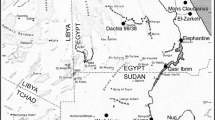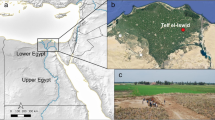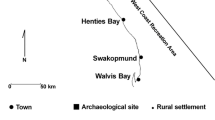Abstract
In this study, we present the preliminary result of archaeobotanical investigation at Kaerdong in western Tibet. The result shows that agropastoralism with combined strategies of foraging, hunting and fishing was in practice at the location between approximately 455 and 700 cal. AD. Our results also show that herding animals grazed at meadows above 4300 m above sea level (masl), and dung was used as fuel. The presence of a rice grain together with spikelet bases indicates that rice was a component of food resources possibly as a result of a trade and exchange system. In addition, tatary buckwheat grains were also recovered at the site.











Similar content being viewed by others
References
d’ A Guedes J (2015) Rethinking the spread of agriculture to the Tibetan plateau. The Holocene 25:1498–1510
d’ A Guedes J (2016) Model building, model testing and the spread of agriculture to the Tibetan plateau. Archaeol Res Asia 5:16–23
d’ A Guedes J, Butler EE (2014) Modeling constraints on the spread of agriculture to southwest China with thermal niche models. Quat Int 349:29–41
d’ A Guedes J, Lu H, Li Y, Spengler R, Wu X, Aldenderfer MS (2014) Moving agriculture onto the Tibetan plateau: the archaeobotanical evidence. Archaeol Anthropol Sci 6:255–269
d’ A Guedes J, Bocinsky RK, Butler EE (2015a) Comment on “Agriculture facilitated permanent human occupation of the Tibetan plateau after 3600 BP”. Science 348:872-b. doi:10.1126/science.aaa4819
d’ A Guedes J, Lu H, Heinc MA, Schmidt AH (2015b) Early evidence for the use of wheat and barley as staple crops on the margins of the Tibetan Plateau. PNAS 112:5625–5630
Ahmad SM (1986) Central Asia and Kashmir. In: Buth GM (ed) Central Asia and western Himalaya: a forgotten link. Scientific Publishers, Jodhpur, pp 1–8
Aldenderfer M (2007) Defining Zhang Zhung ethnicity. An archaeological perspective from far western Tibet. In: Heller A, Orofino G (eds) Discoveries in western Tibet and the western Himalayas. Essays on history, literature, archaeology and art. Brill, Leiden, pp 1–21
Buth GM, Khan M, Lone FA (1986) Antiquity of rice and its introduction in Kashmir. In: Buth GM (ed) Central Asia and western Himalaya: a forgotten link. Scientific Publishers, Jodhpur, pp 63–68
Chen C (2008) Economic history of Tibet. Ganshu People’s Publishing House, Xining (in Chinese)
Chen J, Chen X (2006) Prehistoric cultures in the upper reaches of the Dadu River. Forum Chin Cult 3:5–10 (in Chinese)
Chen F, Dong G, Zhang D et al (2015) Agriculture facilitated permanent human occupation of the Tibetan plateau after 3600 BP. Science 247:248–250. doi:10.1126/science.1259172
Comprehensive Scientific Expedition of Tibetan Plateau, Chinese Academy of Sciences (1984) Agricultural geography in Tibet. Science press, Beijing (in Chinese)
Crawford GW (1983) Paleoethnobotany of the Kameda peninsula of Jomon. Ann Arbor, Michigan
Crawford GW (1987) Ainu ancestors and prehistoric Asian agriculture. J Archaeol Sci 14:201–213
Crawford GW (1992) Prehistoric plant domestication in East Asia. In: Cowan CW, Watson WJ (eds) The origins of agriculture: an international perspective. Smithsonian Institution Press, Washington, pp 7–38
Crawford PJ (2007) Beyond paper: use of plants of Cyperaceae in ancient Egypt. In: Cappers RTJ (ed) Fields of change: progress in African archaeobotany. Barkhuis & Groningen University Library, Groningen, pp 105–113
Dong G, Zhang D, Liu X, Liu F, Chen F, Jones M (2015) Response to comment on “Agriculture facilitated permanent human occupation of the Tibetan Plateau after 3600 B.P”. Science 348:872. doi:10.1126/science.aaa7573
Eleni A, Fuller DQ (2009) Archaeobotanical evidence. In: Evans C, Pettigrew J, Tamtu YK, Turin M (eds) Grounding knowledge/walking land: archaeological research and ethno-historical identity in Central Nepal. McDonald Institute for Archaeological Research, Cambridge, pp 142–152
Fu D (1997) The discovery of carbonized Setaria italica grains at Changguogou site, Tibet. J Sichuan Agric Univ 15(1):145 (in Chinese)
Fu D (2001) Identification and research on the Neolithic crop remains at Changguogou site. Tibet Archaeol 3:66–74 (in Chinese)
Fu D, Xu T, Feng Z (2000) The ancient carbonized barley (Hordeum vulgare L.Var.nudum) kernel discovered in the middle of Yalu Tsanypo river basin in Tibet. Southwest China J Agric Sci 13:38–41 (in Chinese)
Fuller DQ, Zhang H (2007) A preliminary report of the survey archaeobotany of the Upper Ying Valley (Henan Province). In: School of Archaeology and Museology, Peiking Universtiy and Henan Provincial Institute of Cultural Relics and Archaeology (eds) Archaeological discovery and research at the Wangchenggang Site in Dengfeng (2002–2005). Great Elephant Publisher, Zhengzhou, pp916–958 (in Chinese and English)
Guan G (2000) Illustration of weed identification. Science Press, Beijing (in Chinese)
Guo Q (1995) Color illustration of weed identification. Chinese Agricultural Press, Beijing (in Chinese)
Hastorf CA, Wright MF (1998) Interpreting wild seed from archaeological sites: a dung charring experiment from the Andes. J Ethnobiol 18:211–227
Huo W (2005) Archaeological analysis of early civilization in western Tibet. Res Tibet 1:43–50 (in Chinese)
Institue of Biology, Qinghai province (1979) Investigation report of flora and fauna in Ngari Prefecture. Science Press, Beijing (in Chinese)
Ishikawa S (1995) Seeds/fruits of Japan, 2nd edn. Publishing Committee for “Seeds/Fruits of Japan”, Tokyo
Knörzer KH (2000) 3000 years of agriculture in a valley of the high Himalayas. Veg Hist Archaeobotany 9:219–222
Li Y (1998) Chinese weed flora. Chinese Agricultural Press, Beijing (in Chinese)
Liu S, Pan J, Zhang H (1999) The flora of Ngari Prefecture, Tibet. In: Qinghai Institute of Biology (ed) Investigation reports on animals and plants in Ngari Prefecture, Tibet. Science Press, Beijing, pp83–134 (in Chinese)
Liu X, Lister DL, Zhao Z, Staff RA, Jones PJ, Zhou L et al (2016) The virtues of small grain size: potential pathways to a distinguishing feature of Asian wheats. Quat Int 426:107–119
Lone FA, Khan M, Buth GM (1993) Paleoethnobotany: plants and people in Kashmir. Oxford & IBH Publishing, New Delhi
Lu H (2007) Report on the excavation of Dingdong site in Ali, Tibet. Archaeology 11:36–46 (in Chinese)
Lu H (2008) Preliminary analysis of issues on Dingdong site in Ali, western Tibet. Res Tibet 4:56–70 (in Chinese)
Lu H (2016) Colonization of the Tibetan Plateau, permanent settlement, and the spread of agriculture: reflection on current debates on the prehistoric archeology of the Tibetan Plateau. Archaeol Res Asia 5:12–15
Miller N (1984) The use of dung as fuel: an ethnographic example and an archaeological application. Paléorient 10:71–79
Miller N, Smart TL (1984) Intentional burning of dung as fuel: a mechanism for the incorporation of charred seeds into the archaeological record. J Ethnobiol 4:15–28
Moens MF, Wetterstrom W (1988) The agriculture economy of an old kingdom town in Egypt’s West Delta: insight from the plant remains. J Near East Stud 47(3):159–173
Muniz AM, Antipina E (2003) Srubnaya faunas and beyond: a critical assessment of the archaeozoological information from the East European steppe. In: Levine M, Renfrew C, Boyle K (eds) Prehistoric steppe adaptation and the horse. McDonald Institute for Archaeological Research, Cambridge, pp 329–351
Ohnishi O (1998) Search for the wild ancestor of wild buckwheat III. The wild ancestor of cultivated common buckwheat and of tatary buckwheat. Econ Bot 52:123–133
Ohnishi O, Konishi T (2001) Cultivated and wild buckwheat species in eastern Tibet. Fagopyrum 18:3–8
Ohnishi O, Matsuoka Y (1996) Search for the wild ancestor of buckwheat II. Taxonomy of Fagopyrum (Polygonaceae) species based on morphology, isozymes and cpDNA variability. Genes Genet Syst 71:383–390
Reddy SN (1997) Fueling the hearths in India: the role of dung in paleoethnobotanical interpretation. Palcoricnt 24:61–70
Simpson DA, Inglis CA (2001) Cyperaceae of economic, ethnobotanical and horticultural importance: a checklist. Kew Bull 56:257–360
Song S, Wang P (2013) Climate of Tibet. Meteorological Press, Beijing (in Chinese)
Spengler RN III, Frachetti MD, Fritz GJ (2013) Ecotopes and animal herding practices in the steppe and mountain ecotone of central Asia during Bronze and Iron Ages. J Ethnobiol 33:125–147
TAR cultural relics management committee and Department of history of Sichuan university (1985) Changdu Karuo. Science Press, Beijing (in Chinese)
Tong T, Li L, Ciren CL, Yao Y (2015) Gurgyam cemetery and Quta cemetery in Ngari, western Tibet. Archaeology 7:29–50 (in Chinese)
Weisskopf A, Fuller DQ (2014) Buckwheat: origins and development. In: Smith C (ed) Encyclopedia of global archaeology. Springer-Verlag, New York, pp 1025–1028
Wu X, Lin Z (1981) Climatic change during the last 2000 years in Tibet. In: Institute of Weather and Climate Science, Central Academy of Meteorological Sciences (ed) Proceedings of symposium on climatic change. Science Press, Beijing, pp 18–25 (in Chinese)
Xue Y (2010) Study of plant remains from Haimenkou site in Jianchuan County, Yunnan Province Dissertation, Beijing University (in Chinese)
Yang B, Shi Y, Li H (2001) Climatic variations in China over the last two thousand years. Chin Geogr Sci 11:97–103
Yin F, Yang Y, Zheng B, Qian X, Xie G, Liu G, Yu D, Zhu T (1930) Summary of Tibet. Chinese Printing Company, Nanjing (in Chinese)
Zhang Z, Guo Q (1995) Illustration of weed identification. Chinese Agricultural Press, Beijing (in Chinese)
Zhao Z (2004) Flotation-field work method of Paleoethnobotany. Archaeology 3:80–87 (in Chinese)
Zhao Z, Chen J (2011) Analysis of flotation results from the Yingpanshan site, Mao County, Sichuan Province. Relics South 3:60–67 (in Chinese)
Acknowledgements
The authors thank Professor Gary W. Crawford for his help in the editing and comments of earlier manuscripts. We thank Jingang Yang from the Chinese Academy of Social Sciences for his help in identification, Feng Yang and Shuai Li from Sichuan University and Xiawu Kaxian from Tibet University for their help in collecting and processing the soil samples. We also appreciate the two anonymous reviewers for their comments to improve the quality of our manuscript. The research was supported by “General Programs of the National Social Science Fund of China (16BKG001 and 14BKG005)”, “Major programs of the National Social Science Fund of China (12&ZD151)”, “The Fundamental Research Funds for the Central Universities—Sichuan University (skyb201206)” and “Research Initiation Funds for introduced talents of Sichuan University”.
Author information
Authors and Affiliations
Corresponding author
Rights and permissions
About this article
Cite this article
Song, J., Lu, H., Zhang, Z. et al. Archaeobotanical remains from the mid-first millennium AD site of Kaerdong in western Tibet. Archaeol Anthropol Sci 10, 2015–2026 (2018). https://doi.org/10.1007/s12520-017-0521-6
Received:
Accepted:
Published:
Issue Date:
DOI: https://doi.org/10.1007/s12520-017-0521-6




